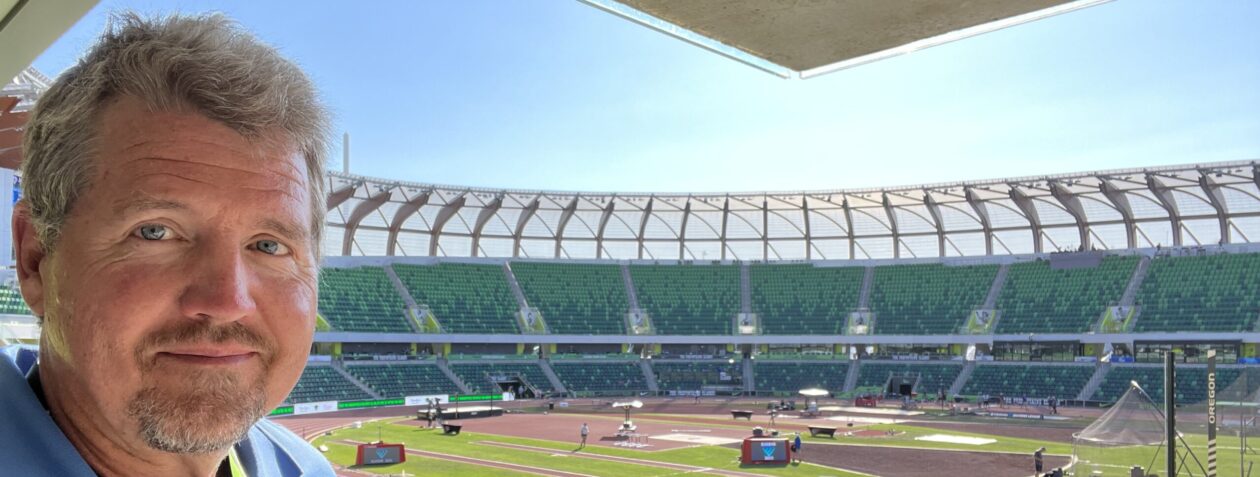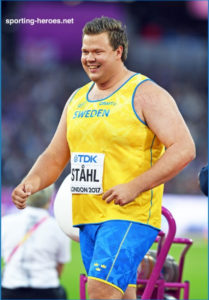
This Sunday’s Prefontaine Classic—to be held at Stanford University due to the ongoing overhaul of the Temple of Track in Eugene—will feature a rollicking women’s shot put competition. Some of the best putters in the history of the sport will be there, along with a corps of youngsters vying to make their mark. Here are three questions for throws obsessives to ponder as the meet approaches.
Can Michelle Carter Recapture the Magic?
It’s not easy to stay on top in this business.
For Michelle Carter, it was a long climb just to get there. She was U20 World Champion in 2004. In 2008 she won the first of her seven outdoor national titles. In 2009, she competed in her first World Championship, taking fifth in Berlin. In 2012, she took silver at the Indoor Worlds and fourth at the London Olympics. Finally, in 2016 she broke through with a dramatic final-round 20.21m bomb to take gold at the Indoor Worlds.
She repeated that feat a few months later in Rio, launching an American record of 20.63m on her sixth attempt. It was one of the great moments in the history of American shot putting and definitively established her as the best thrower in the world and possibly in the Carter family as well.
Unfortunately, she has struggled since, slipping to third at the 2017 World Championships with a 19.14m effort. Last year she posted her lowest season’s best (18.16m) since 2007, and in her only competition so far this season put 18.28m.
I had a pleasantly rambling chat recently with Nathan Fanger (coach of Danniel Thomas-Dodd who will also be competing at the Pre) and he pointed out how difficult it is to compete at the highest level of this sport over a long period of time.
He made the point that a professional athlete has to be selfish. “You wake up in the morning and your breakfast has to be just right…you train hard all day and you might come home exhausted and edgy. Then you have to go to bed at a certain time. Day in and day out, everything has to revolve around you, which is fine when you’re young and single, but when you get married and have a family that gets tough.”
Michelle got married last year. And had knee surgery. And turned thirty-three.
Not many throwers compete for World or Olympic medals at that age, but count me among those who hope that she returns to her butt-beating ways. Round six in Doha might be kind of dull without her.
Is it Possible to Throw Twenty Meters on No Sleep?

Germany’s Christina Schwanitz had a heck of a 2015 season, winning the World Championships and setting a massive PR of 20.77m. She followed that up with a lackluster sixth-place finish at the 2016 Olympics. She followed that up by giving birth to twins.
A guy I teach with became the father of twins two years ago, and it transformed him from a fit, happy-go-lucky sort of man into an exhausted, haunted-looking creature who no longer gets asked to play on the faculty dodgeball team.
Schwanitz, obviously made of sterner stuff, was able to come back last year after sitting out the 2017 campaign and post a remarkable 19.78m season’s best.
She is the same age as Michelle Carter, and likely shares the same goal: to close her career with medals in Doha and Tokyo.
Sunday’s Pre, Schwanitz’s first outdoor meet ever on American soil, should provide some indication of how likely she is to achieve that.
How is Chase Ealey Doing What She’s Doing?

Here’s what I know about Chase.
She was a fine college shot putter, finishing second at the 2016 NCAA meet while representing Oklahoma State University. She also finished seventh at the Olympic Trials that year with a toss of 18.46m.
As a glider.
In 2017 and 2018 videos of her throws would pop up on social media occasionally as she tried to build a post-collegiate career. She notched season bests those years of 17.79m and 17.78m respectively.
As a glider.
This past winter, videos of Chase throwing began appearing on Ryan Whiting’s Desert High Performance Instagram page.
But now, she was spinning.
I happened to run into Whiting at a clinic this winter, and I asked him how Chase’s glide-to-spin transition was going. He said she was doing just fine, thanks.
I interpreted this to mean that she was struggling mightily as putters commonly do when switching techniques, but that she was staying positive. I also felt admiration for her courage in adopting the rotational style when it was clearly going to take her a few years to get comfortable with it.
Then, on February 9th, she threw a PR of 18.84m. “Good for her!” I remember thinking. “A PB during her first year as a spinner? Outstanding!”
Then, on February 24th, she won the US Indoor Championships with a toss of 18.62m.
Then, the outdoor season began and things got really strange.
She raised her PB to 18.95m on a trip to New Zealand in March, before returning home and blasting a 19.37m toss in Arizona, her home base when training with Whiting.
That earned her a May appearance at the Diamond League meeting in Shanghai. It generally takes throwers a couple of seasons to get acclimated to the rigors of traveling to compete overseas, even those who have not completely changed their technique over the past six moths. It would have been perfectly understandable for Ealey to wilt under the pressure of traveling halfway across the globe to take on the likes of Lijiao Gong, Anita Marton, and Danniel Thomas-Dodd (all World Championships medalists and all, by the way, appearing Sunday at the Pre) but instead she put 19.58m for the win.
She followed that up over the next few weeks by tossing 19.21m in Nanjing, 19.38m in Finland, and 19.20m in Norway, making it clear that it had not taken her long to adapt to the rigors of travel.
I asked Coach Fanger how in the world Ealey could be so consistent so quickly after switching to a technique whose best and most experienced practitioners experience bouts of maddening inconsistency.
He said that the secret may lie in Ealey’s particular version of the rotational technique.
“She is very slow out of the back, “ he told me, “and has a heck of a strike. She’s long and really drives the ball like a glider.”
“She starts slow enough,” he continued, “that she doesn’t lose control and then she’s still able to smack the finish. She’s similar to Ryan Crouser in that sense.”
As Coach Fanger sees it, rotational throwers are often erratic “because they are a little spastic out of the back, but if you can control the back it doesn’t have to be that way,”
He pointed out that some throwers, Joe Kovacs for example, have to be fast out of the back because of their stature.
“The shorter throwers like Joe or Adam Nelson back in the day have to use speed to throw far because they don’t have long levers. It’s a trade off, though. They are sometimes inconsistent because they have to be as fast and dynamic as possible even at the start of the throw.”
So what happens a couple of years from now when Ealey gets more comfortable with her technique and becomes more dynamic out of the back?
Tune in to the Pre this Sunday, and you might just get a glimpse of America’s next great putter.
Here is the start list for what should be a fantastic competition.






























